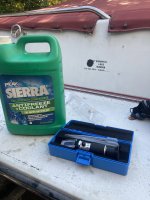- Joined
- Jul 18, 2011
- Messages
- 18,820
It is that 'special' time of year in the northern regions where boats (and their engines) need to get winterized. Based on the winter incidents from last year (or 2), we are now including Texas as a 'Northern' state in the USA 
Anyway, as a Public Service Announcement . . . Please be aware that the Antifreeze ratings that you see advertised, like -50˚F, -100˚F, etc. are PIPE BURST ratings, which is a rating established by the plumbing industry in the 1930's (or so). It is the temperature at which a copper pipe will burst. The actual freezing and expansion of the AF starts at much higher temperatures and can (does) damage plastic parts in a boat engine's cooling and/or a boat's plumbing systems.
Knowing this fact, companies (like West Marine) have provided guidance on the spec's for the Marine AF that they sell. Here is the info from the -50˚F AF . . .
"Ideal for regions that experience temperature ranges between 14°F to 18°F (-8°C to -10°C); for colder regions we recommend using non-toxic West Marine antifreeze with a -60°F or -100°F rating"
Folks in many northern regions may want to be thinking about the lower temperature rated AF versions (-60, -75, -100) to provide adequate protection.
FWIW - I was fighting a fresh water system leak in my boat all summer only to find out that the plastic strainer bowl that is between the water tank and the pressure pump had cracked due to prior insufficient winterization (i.e. -50˚F). Years ago my sea water strainer (on a previous boat) suffered similar fate (cracking) from using the -50˚F stuff where winter temperatures reached around -10˚F.
My 'new' boat has sea water strainers and a few other plastic parts in the engine cooling system that could experience similar fate at temperatures approaching 0˚F and lower.
Then there is the whole PG vs. Alcohol thing, but that is a story for another time
Anyway, as a Public Service Announcement . . . Please be aware that the Antifreeze ratings that you see advertised, like -50˚F, -100˚F, etc. are PIPE BURST ratings, which is a rating established by the plumbing industry in the 1930's (or so). It is the temperature at which a copper pipe will burst. The actual freezing and expansion of the AF starts at much higher temperatures and can (does) damage plastic parts in a boat engine's cooling and/or a boat's plumbing systems.
Knowing this fact, companies (like West Marine) have provided guidance on the spec's for the Marine AF that they sell. Here is the info from the -50˚F AF . . .
"Ideal for regions that experience temperature ranges between 14°F to 18°F (-8°C to -10°C); for colder regions we recommend using non-toxic West Marine antifreeze with a -60°F or -100°F rating"
Folks in many northern regions may want to be thinking about the lower temperature rated AF versions (-60, -75, -100) to provide adequate protection.
FWIW - I was fighting a fresh water system leak in my boat all summer only to find out that the plastic strainer bowl that is between the water tank and the pressure pump had cracked due to prior insufficient winterization (i.e. -50˚F). Years ago my sea water strainer (on a previous boat) suffered similar fate (cracking) from using the -50˚F stuff where winter temperatures reached around -10˚F.
My 'new' boat has sea water strainers and a few other plastic parts in the engine cooling system that could experience similar fate at temperatures approaching 0˚F and lower.
Then there is the whole PG vs. Alcohol thing, but that is a story for another time




















